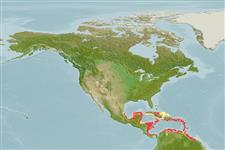Common names from other countries
Classification / Names / Names
Namen | Synonyme | Catalog of Fishes (gen., sp.) | ITIS | CoL | WoRMS
Environment: milieu / climate zone / depth range / distribution range
Ökologie
; tiefenbereich 0 - 44 m (Ref. 83435). Tropical; 23°N - 6°N, 93°E - 53°E (Ref. 83435)
Western Central Atlantic.
Length at first maturity / Size / Gewicht / Alter
Maturity: Lm ? range ? - ? cm Max length : 18.2 cm DL Männchen/unbestimmt; (Ref. 83435); common length : 15.0 cm TL Männchen/unbestimmt; (Ref. 355)
Shell thick, pear-shaped, with large body whorl. Spire short, last few whorls bear single or double rows of spines. Suture deeply channelled. Anterior canal short and broad. Base of shell sometimes with a row of smaller, blunt spines. Colour: purplish brown, light grey, or white, with bluish, brownish or greyish bands.
Inhabits coastal lagoons, mangroves, river estuaries, and other low-salinity environments (Ref. 355).
Life cycle and mating behavior
Geschlechtsreife | Fortpflanzung | Ablaichen | Eier | Fecundity | Larven
This species is a non-broadcast spawner. Life cycle does not include trocophore stage. Also Ref. 833.
Leal, J.H. 2003. (Ref. 355)
IUCN Rote Liste Status (Ref. 130435)
CITES Status (Ref. 108899)
Not Evaluated
Not Evaluated
Bedrohung für Menschen
Harmless
Nutzung durch Menschen
Fischereien: kommerziell
| FishSource |
Tools
Mehr Information
Alter/GrößeWachstumLänge-GewichtLänge-LängeMorphologieLarvenDichte
Internet Quellen
Estimates based on models
Preferred temperature
(Ref.
115969): 26.4 - 28.2, mean 27.6 (based on 110 cells).
Preiskategorie
Unknown.
